Now, numbers aren't everything of course. We're constantly reminded by those who would argue for the necessity of Vatican II and everything that followed from it that it's the qualitative measures that matter--people are living their faith much more fully that before. We'll consider that proposition in our future posts on the actual content of the publication. But for now, let's just look at some charts I made in Excel yesterday afternoon. Some of these may be posted by Orville at as well:
First, the Catholic population:
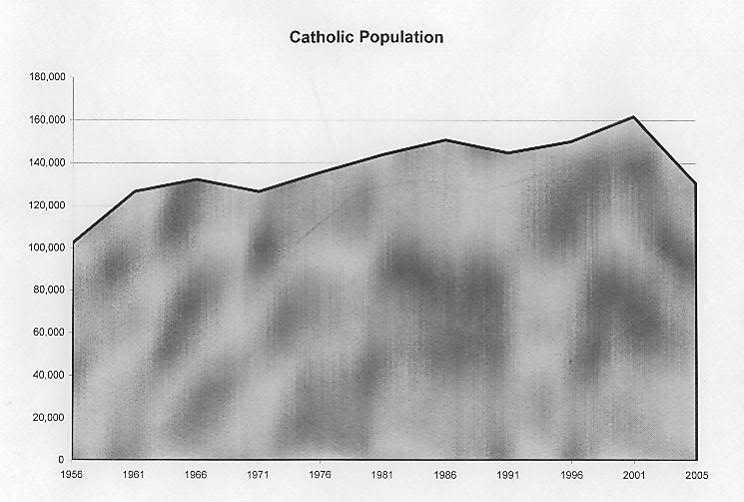
Hmm. A pretty slow increase. How does this compare to the total population of the Diocese? That information is necessary to tell whether there is a real increase or a real decrease in the number of people who bother to register at a parish, won't it? As for the decline from 2001 to 2005 (over 30,000 people), I have to ask what happened? Did Bp. Finn really drive off 30,000 souls in less than a year as our ordinary? Somehow I doubt it, don't you? Maybe certain pastors in larger parishes were sandbagging before, so the numbers wouldn't look bad in Bp. Boland's days, but are trying to make Finn look bad now? Maybe Bp. Finn has insisted on a more accurate count? Maybe Finn is adjusting the numbers down so as to lower the money he has to send to Skylstad and Wuerl and the corrupt, vile USCCB?
Now for the decline in priests:
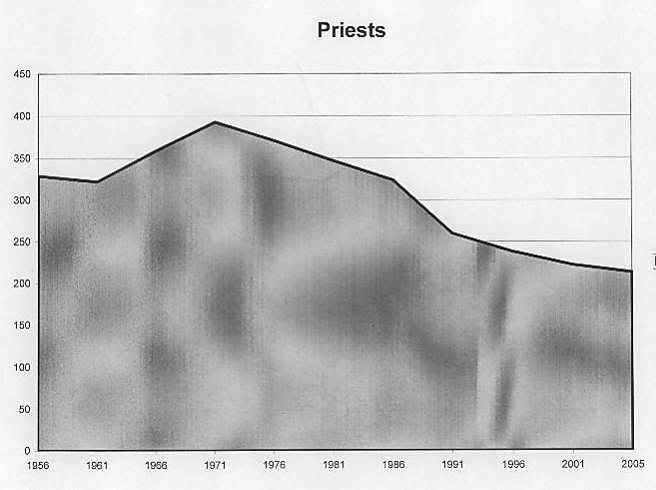
Theres a decline from 393 priests in 1971 to 213 in 2005. Hmm. Anyone notice that there was a bump in priests during the second Vatican Council? What happened? As to the increase, one hypothesis to this may be that lots of young men were entering the priesthood, without real vocations or uncommitted to celibacy, but lured by the progressive forces in the diocese into thinking that the priesthood is about to become something totally different and oh-so-much-cooler-than-it-used-to-be? How did that little spurt pan out? Note that the beginning decline in priests coincides almost exactly with the introduction of Bugnini's novus ordo Mass. Surely a coincidence, eh?
Now for the decline in religious sisters and brothers:
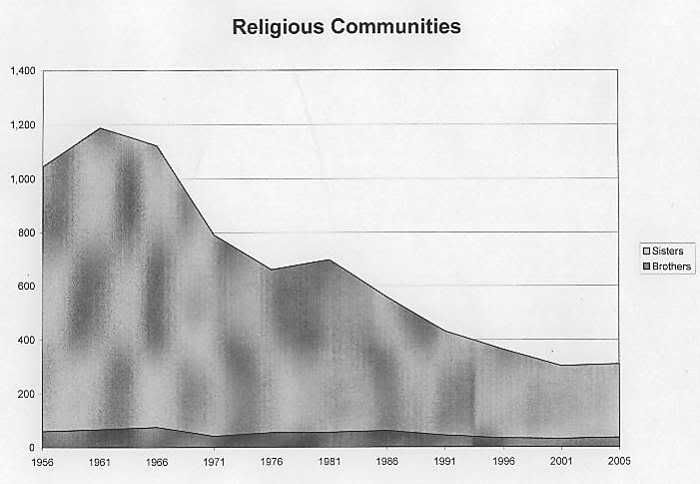
Their degeneration started earlier than the priests' decline, from a peak of almost 1200 in 1961 to less than 300 now. Of course, the aggiornamento started among religious communities well before we got the introduction of the novus ordo, didn't it?
Just to drive home the point, let's look at the trend in total religious vocations (priests, nuns, brothers):

We've seen a drop from one religious vocation for every 74 Catholics in 1956 to one religious vocation for every 249 Catholics in 2005 (granted, it's up from one in 308 Catholics in 2001, with the relative improvement in the ratio actually due to a decrease in the Catholic population which outpaced the decrease in vocations. What an improvement!).
Now for education. One would expect a growth in schools in response to Vatican II's call for a New Evangelization, right?
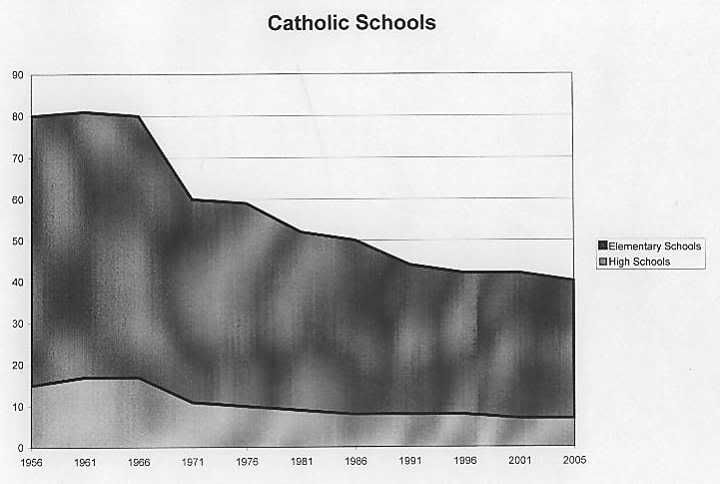
Um, yeah. The drop from 65 elementary schools and 15 secondary schools in 1956 to 33 elementary schools and 7 secondary schools in 2005 is a sure sign of the New Springtime!
On that note, what I'd like to know is the number of children (and the percentage of children) in Catholic schools, and also how much of an increase there was (in constant dollars) in Catholic school tuition (a factor very much related into the religious vocations data above).
Finally (for now), let's look at a statistic I derived from the raw data given to us by the Key: child baptisms per Catholic:
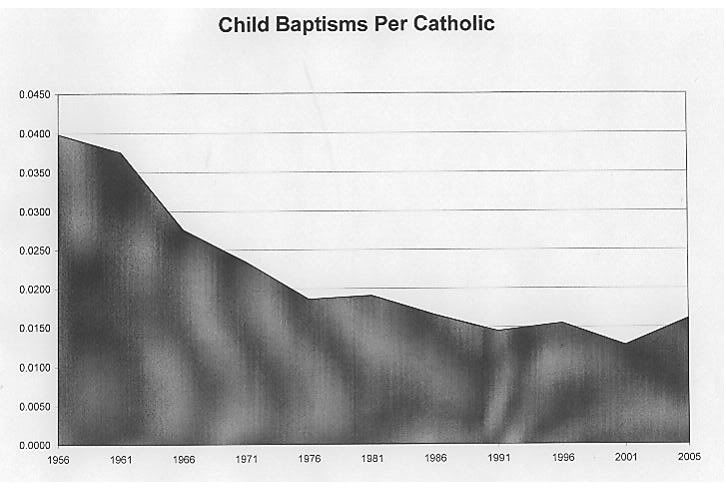
There were almost 0.040 child baptisms per Catholic in 1956 (that's one new bambino for every 25 Catholics), but only 0.016 child baptisms per Catholic in 2005 (one for every 62 Catholics). Granted, we're up from a low point of 0.013 baptisms in 2001 (one for every 79 Catholics, due both to a smaller base of Catholics and to more breeding among those that remained). But what were we saying about how postconciliar Catholics are living their faith much more fully than before? How does this square with Humanae Vitae?
We're skipping over "adult baptisms" for now, because they adulterated the data set in the contemptible little mag by adding in conversions from the heretical sects beginning in 1986. That data set isn't useful unless we add conversions prior to 1986 or pull out conversions from 1986 forward. In either case, it seems that the flat line we would see for new adult Catholics would become a downward slope. And, of course, that's not to speak to the quality of instruction those adults have received or how many subsequently left the Church when they found out--long after RCIA--that Catholic faith didn't comport with their protestant lifestyle.
There's more to come, folks, and we'll update this if and when we get good total population data (and while we're at it, if we get additional data on other things--declarations of marital nullity, for instance). But that's enough to digest in one sitting, now, isn't it?
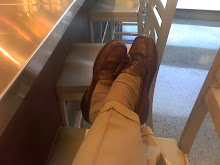

2 comments:
I recall seeing a book, printed in 1955 or so, about women's religious communities. I can't remember the exact title, but "The Field Guide to North American Nuns" gives you the general idea. Each community had a 1 page synopsis, describing their mode of life, a photo of their habit and a few other vital stats. I was surprised by the number of "sensible shoes and pants suits" habits that nuns were running around in even then. Quite a few of them looked like stewardesses for Pan-Am, complete with pill-box hats.
I bring this up to say that I think the Council was meerely the outward sign of an illness that had taken root long before. Sort of like the enormous oak tree that turns out to have a hollow core.
Sean -- excellent point; you are
in fact correct. There were many
'modernizing' changes to the
Church's Liturgy and to Catholic's lives through the 1950s and 1960s
that I am aware of. A little
research on your part will enable
you to find dates and names,
places and documents. The trail
is not hard to follow.
However, I'd caution anyone to
avoid naming names too often when
doing this sort of research --
when I ask those who are older
than I am the question of 'What
exactly took place when the
Liturgy changed?', or, 'What do
you remember about the changes in
the Liturgy?', I find that I get
surprising answers. I hear things
like "It came at the perfect time
-- the changes just fit right into
place," and, "I really liked the
changes."
So in other words, Vatican II
found a willing and complicit
audience. The songs were on the
radio first, and then the hit TV
show came out. And then everybody
got excited about the soon-to-be-
released movie that was due in
theatres around the country that
summer, and then finally the whole
story was released on the silver
screen. Did you get the DVD yet?
Wait'll you see the 'extras'. The
bit at the end practically makes
the case for a sequel.
So anyway, when *I* dig around for
the details, to be honest, the
most important thing I look for
is clear evidence of malicious
intent, or evidence of an agenda.
I found this in spades. And by
doing so, I realized that some of
the people involved with the
changes were not guilty of anything
other than making a choice towards
what they thought was the best
thing to do. Many others didn't
have it in them to protest. God
gives us all different abilities
and graces with which to interpret
the world.
Those *with* an agenda, however,
typically gave evidence of
disliking the Catholic Church in
the first place; and clearly sought
to take away that which was good
and holy, and replace it with
less prayer and things that would
change the traditions of the
Catholic Church entirely. One
of those with an agenda appears to
have been a Freemason.
The key to implementing the changes
of those who sought to do harm
was simply to make the word
'change' sound like 'tradition
from organic growth'. Sound
impossible? The Fall of Man in
the Garden of Eden happened along
similar such lines of subtle
word-play and innuendo.
So, the historical record is
important. As a Catholic, however,
I must forgive those who hated the
Church -- I must always remember
that my sins are forgiven AS I
forgive the sins of others. The
important thing to keep in mind at
this point is that the Church
remains, and it is our sacred
responsibility to remain obedient
to Her in all things. Also, it
is important to remember that the
Tridentine Latin Mass has survived
and that it is also flourishing
in one of the most liberal parts
of the world. Amongst those who
are traditionalists, this last
point often appears to have been
forgotten.
Our proper change agents are:
Prayer, holiness, and respectful
dialogue with our superiors and
with our separated brethren. It
is also proper to be careful about
our words. So, lest you think I'm
naive and I that I must have a
collection of Barney videos in my
house somewhere, let me also say
that I believe that the word
ECUMENISM has room in it for
respect towards the Catholic Church
and Her ancient traditions.
We must work within the Church to
effect change. The Tridentine
Latin Mass has survived almost
miraculously; and there are those
who will do nearly anything to
make sure they attend it as often
as possible. And yet, nobody has
ever given serious thought to
things like a 30-second national
television commercial that would
advertise the Tridentine Latin
Mass.
Now, certainly this is within our
abilities. And given the fact
that such commercials have been
made recently that appear to
slander the Catholic Church, I
seriously wonder at times if
traditionalists are happily moving
forward and trying to build on
what they've already achieved, or
are they enjoying too much the
acts of 'gretzing' about the past,
and enjoying the intrigue of it
all.
Here's my 30-second commercial:
(Opening: Gregorian Chant, close-
focus on incense-smoke from
thurible)
Words to fade-in and fade-out over
slow-mo video of a Latin Mass:
The Church is still here. . . .
The Tridentine Latin Mass is in
your area. . . .
All are welcome. . . .
All are called.
Join your ancestors, and the
Saints that have come before you.
. . .
(Pause. And then the sound of
bells ringing, children laughing.
Camera shows teenagers walking
out of Church, smiling, with
their parents).
Other, better, commercials could
probably be made. Other things
could also be done. Why, for
example, are hoagie-sales (for
money-raising purposes) typically
found only in Protestant parishes?
Also, how many Catholics have
read Dominus Iesus, and held
'townhalls' advertising their
Church and their faith? There are
plenty of things to do and try;
and we don't seem to have tried
to do very many of them. I do
not mean to take a shot at hard-
working Catholics, here -- I am
more than fully aware of all the
Catholic charities, and all the
ministries in our hospitals and
schools. Though I believe it is
time that Latin Mass Catholics
move more eloquently and happily
into the world around them.
Hoagie-sales should be a priority.
And yes, it is because I love to
eat hoagies. But it is also
because few in the hoagie-eating
crowd have ever heard about the
Tridentine Latin Mass.
Get my point?
-tim
Post a Comment